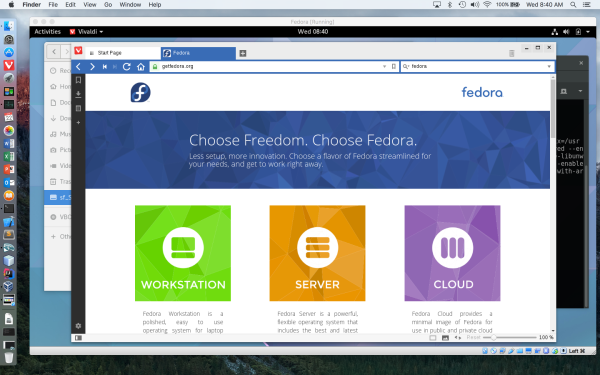
I installed Fedora 24 last night using VirtualBox 5.0.22 on my MBP running OS X 10.11.5. It was remarkable for several reasons, not the least being just how easy it was to get this Fedora 24 up and running. For anyone interested in doing the same, the steps are straightforward enough:
- install VirtualBox, making sure you’ve also downloaded the VirtualBox Additions ISO that matches the VirtualBox version you’re installing
- install Fedora as a guest VM inside VirtualBox
- update Fedora after the initial installation using dnf
- install gcc and kernel-devel using dnf
- reboot/restart the Fedora VM
- mount the VirtualBox Additions ISO so that the Fedora VM can see it at /run/media/fedora/VBOXADDITIONS…
- run VBoxLinuxAdditions.run on the mounted ISO as root
- reboot the VM and, at a minimum, pick a better VM desktop resolution than 1024×768; I chose 1360×768
If you’ve enabled shared folders between the Fedora VM and OS X, then make sure to add your Fedora login account to the vboxsf group with the usermod (sudo usermod -G vboxsf [account name]) command. This will give you filesystem rights to read/write to the mounted shared folder.
Right after getting Fedora 24 up I installed Vivaldi. It’s not in any repo so you have to download the RPM. Before you do that, you have to add a library dependency, libXss.so.1. I discovered that dnf will do that nicely with “sudo dnf install libXss.so.1”. It did all the gnarly work of looking up what applications needed to be installed that included that library and then installed it (turns out it was an X screen saver). In the past I had to go find this by searching on the web. So it’s nice to find that particularly rough edge smoothed off. It would have been even better if rpm had linked in with dnf and offered to install that dependency for you along with Vivaldi, shortening the installation even further.
I haven’t tried every Linux distribution, but the main ones I have tried (Fedora, CentOS, Ubuntu, Arch Linux ARM) have been quite easy to install and maintain and a real pleasure to use. They have all provided critical up-to-date tools (especially Fedora, Ubuntu, and Arch Linux) and features across all the platforms I work on. In the past I used to whine about Linux’s inability to play back DVDs or display Flash video. Today DVDs have been replaced by streaming, and anything worth streaming comes across via HTML5, which all the Linux browsers support. As time has marched on I’ve discovered DVD/BlueRay and Flash playback has grown completely irrelevant.
What I’ve learned and come to fully appreciate is that Linux does something far more valuable than acting as a platform for merely consuming content; it’s an open, powerful, flexible, and valuable platform for unbounded creative use.

You must be logged in to post a comment.